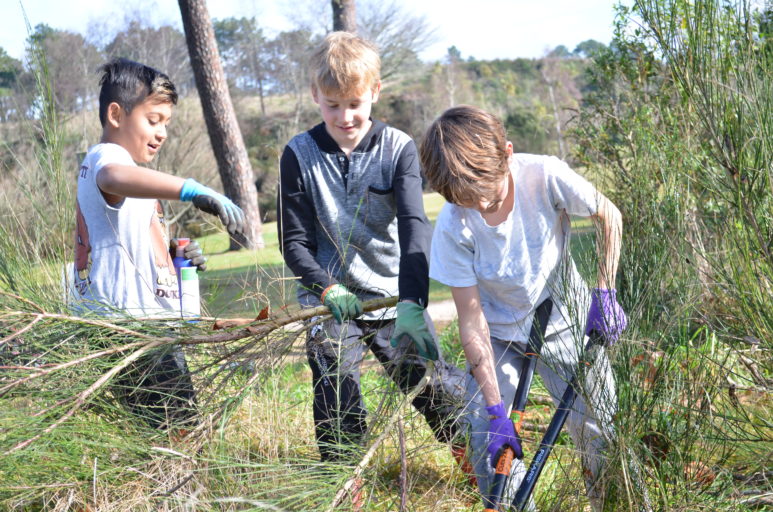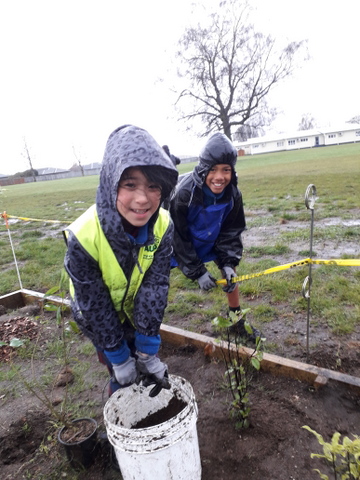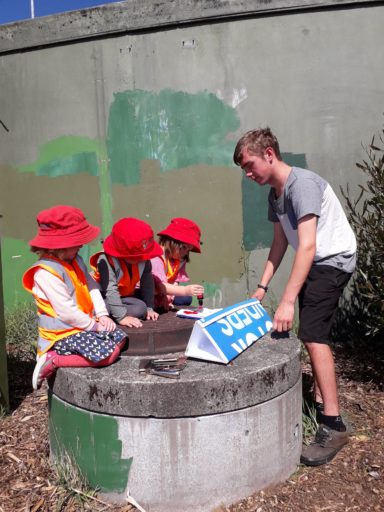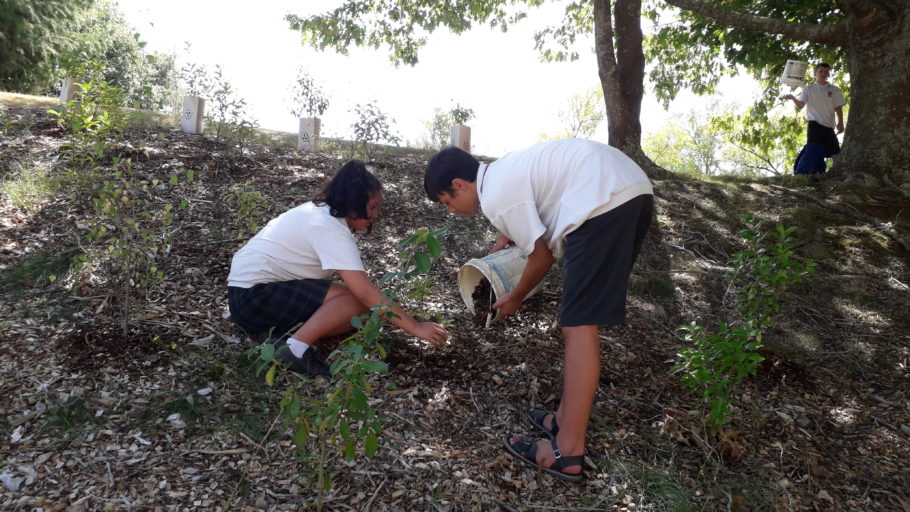In Taupō, Kids Greening Taupō are helping students of all ages to connect with nature and take part in real life conservation projects contributing to their community. Thea DePetris and Rachel Thompson are education coordinators for Kids Greening Taupō, an environmental education programme based on a model of Collaborative Community Education where schools work with community partners on conservation projects.

Collaborative Community Education involves real-life projects, lots of community collaboration and fostering student-led opportunities. Connecting with nature can involve all kinds of activities, depending on the age, interests and passions of the children taking part.
“It all depends on the student year level and where the school is in terms of their own priorities for using the natural environment as a learning context,” says Thea. “I really believe in working with early childhood centres, with plenty of nature-based play and sensory activities to foster connection with nature.”
It can change the way children view and interact with nature in very fundamental ways.
“When we look inside a compost bin, initially many children want to ‘smoosh’ the worms and slaters,” says Thea, “But once we talk about the worms as living creatures and hold them in our hands it’s incredible how quickly the children’s attitudes change. I believe early childhood is a really pivotal stage of development so its important children have plenty of access to nature.”

Kids Greening Taupō also works with primary and secondary schools.
“The primary kids are like sponges,” says Thea. “They suck up everything and really get stuck into practical restoration work.”
Thea and Rachel encourage schools taking part in the programme to adopt a nature space or restoration area within walking distance. Then over time, the idea is to create a long-term plan through student feedback and begin the mahi necessary to turn the plan into reality. Through teacher professional development and encouragement of managerial buy-in, Kids Greening Taupō supports school-wide participation within these spaces, not only using them as a place for the hands-on work but also for integrating nature as a learning context across the curriculum.
Every second week, approximately two hours of coordinator time is spent at each school on the ground with teachers and students.
“The support depends on what the teacher’s passion is. We also try to link with a ‘champion’ teacher in schools who will have meetings and enthuse the whole staff to contribute to ‘greening’ our town,” Thea says.
Schools that have their own restoration area have the opportunity to set up T-Rex traps, but not all schools have a trapping programme.
“Trapping needs the right teacher to be involved,” Thea believes. “They need to be committed to keeping it going and ensure regular rebaiting happens for example.”

“We also have a Ranger Programme in our participating primary schools for those tamariki who are especially keen to further develop their conservation knowledge and skills,” Thea explains. “In Terms 1 and 4 we have four ranger sessions with the really keen kids, exploring the themes of ‘invertebrates’, ‘plants’, ‘weeds’ and ‘introduced predators’.”
For secondary school pupils there is the opportunity to apply for a space on the Kids Greening Taupō’s ‘Student Leadership Team’ whose members work closely with the community to organise collaborative community projects. It’s a serious application process as these students represent our future community environmental leaders.
“Last year was the first year we had a full application process,” says Thea. “It is a formal selection process, like applying for a job, which the students need to take seriously. There is a sense of accomplishment for team members, and plenty of encouragement to reapply the following year for those who do not make the cut.”
The 2020 selection process is taking place at the moment.
Both the primary-age ‘Rangers’ and the secondary ‘Leadership Team’ are coordinator-led rather than teacher led. Both teams do plenty of hands-on restoration work like setting out tracking tunnels to detect introduced predators, carrying out bird surveys, planting of native trees and biodiversity surveying. For the leadership students, local experts facilitate learning about a range of knowledge and skills, such as effective communication and consultation, all which better enable these young people to organise and lead community events and programme development.
Taupo’s ‘Spa Park’ is becoming something of a showcase project for the Kids Greening Taupō Student Leadership Team.
“Spa Park is a recreational park in the town centre and for those of us who know about native vegetation, it is a ‘nature void’, full of plenty of grass and weeds,” says Thea. “The Student Leadership Team have adopted the area, where they hold a big community planting every year. With support from the Taupō District Council and Waikato Regional Council, they’re slowing getting rid of the weeds and bringing back the bird song. It’s a journey with the local community. Taupō is seen as a ‘magical environment’ with the volcanic lake,” she continues, “but there’s actually not much bush where native fauna and flora thrives.”
Slowly, steadily, Kids Greening Taupō hopes that will change. Last year, for example, those taking part in the Collaborative Community Education programme notched up some impressive achievements:
- 2268 student volunteer hours actively restoring project areas
- 373 volunteer hours from representatives from partnering organizations and local experts
- 6000 trees planted
- $74,335 in-kind donations from local businesses and organizations
- $104,090 funding from sponsors and funders
- 4 kindergartens, 8 schools and 40 link teachers involved
Already this year, as part of cross-curriculum work on the theme of ‘Giving Back to Community’, fifty Year 9 secondary pupils have been doing their bit to improve Spa Park, with a recent working bee carrying out mulching at the park.

The ‘Collaborative Community Education’ which underlies ‘Kids Greening Taupo’ was inspired by and based on ‘Kids Restore the Kepler’, a long-time conservation education programme running in Te Anau.
“Back when the Department of Conservation was taking a stock take of what was happening in the conservation education space around Aotearoa, Kids Restore the Kepler caught their eye,” says Thea, “The programme’s underprinning principles of utilising a real-life opportunity, plenty of community collaboration and fostering student-led opportunities were identified then as best practice education. Kids Greening Taupō was initiated as a means to determine if a similar programme could be replicated in an urban area.”
Commencing in 2015, Kids Greening Taupō became the pilot programme of the Collaborative Community Education Model.
“Now there are five other projects around New Zealand, including ‘Townbelt Kaitiaki’ in Dunedin, the Healthy Opawaho project in Christchurch and another project emerging around the Porirua Harbour,” says Thea. “Collaborative Community Education is an opportunity to create positive change in communities based on an authentic context and lots of collaboration with the local community. In a complex, uncertain world, it is a great way to give our rangatahi hope that they can make a difference and make the world a better place. Today, I think this is paramount.”
It’s not just about the students either.
“An important goal and key part of the programme is teacher professional development,” says Thea, “giving teachers the confidence to regularly take rangatahi outdoors and utilise the natural environment and sustainability as an engaging and effective learning context.”
The experience can be life-changing for some of those taking part in the programme.
“Some kids have special talents and interests, and we do our best to help them pursue these” says Thea. “For one of our leaders, trapping is his thing. So we connected him with a professional pest control expert from the Wairakei International Golf Course and Sanctuary through which he gained hands-on experience. Now recently graduated, James looks set to enroll in a Trainee Ranger course through which he is hoping to work for the Department of Conservation eventually.”
Then there is Sian Moffatt who was a member of the first Kids Greening Taupō Student Leadership Team as a Year 13 student.
“Way back when Sian was applying for university, she was pretty sure she was headed for a degree in design,” says Thea. “But as Sian will tell you, becoming involved in Kids Greening Taupō and then soon followed by participation in the Sir Peter Blake Youth Forum and Kiwi Forever programmes, she found her passion. Design was scratched and a degree in environmental science and conservation biology at Victoria University eventuated instead.”
“During university, Sian co-led the Forest and Bird youth chapter, and following graduation, came back to Taupō and got a job with Kids Greening Taupō. She’s young, enthusiastic and committed to connecting youth with nature – we could have never asked for a better asset to our team of education coordinators!”

